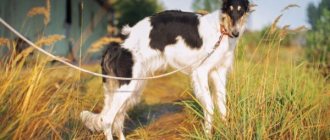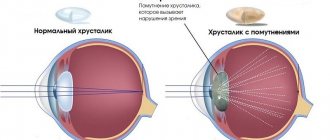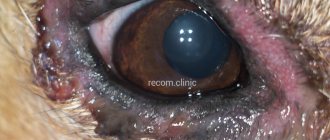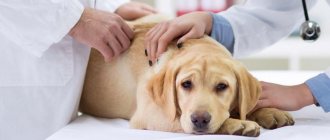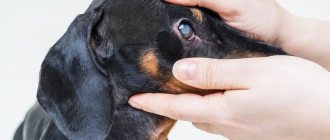Atony of the bladder is characterized by a weakening of the tone of the walls of the bladder, their overstretching, and a pronounced decrease in contractility. At the same time, the bladder increases significantly in size, urine stagnates in it, and when it is full, involuntary dripping and leakage of urine is observed.
The main symptom of atony is urinary incontinence. The volume of urine produced depends on the degree of weakening of the bladder (detrusor) muscles. Sometimes urine leaks in drops, sometimes it comes out in large volumes. When you try to empty your bladder on your own, urine comes out in a weak stream. Characteristic is the absence of the urge to urinate when the bladder is full.
Signs
Symptoms of bladder atony in dogs:
- an overstretched bladder is palpated;
- pressing on the abdominal wall can cause emptying of the bladder;
- urine comes out in a thin stream, drop by drop;
- abdominal pain;
- urinary incontinence;
- tendency to recurrent urinary tract infections.
Causes
With various neurological problems, a violation of the innervation of the bladder occurs (there is no adequate control over the functioning of the muscles of the bladder walls).
Pathologies causing compression, damage to the spinal cord:
- cauda equina
syndrome ; - discopathy;
- fracture, spinal injury;
- tumor;
- congenital malformation.
Damage to the nerve fibers extending from the sacral segment of the spinal cord occurs during pelvic fractures and operations on the prostate gland.
Also, possible causes include neuropathies, diseases of the midbrain (separation of the muscles of the bladder and urethra), dysautonomia (decreased contractility of the detrusor).
Long-term blockage of the urethra, accompanied by overfilling of the bladder, stretching of its walls and further dysfunction, occurs with a tumor of the bladder, a stone in the urethra, or with hyperplasia (enlargement) of the prostate gland.
Frequent complications of the disease are severe cystitis and postrenal uremia (increased renal parameters in the blood serum, intoxication of the body due to urinary retention).
Diagnostics
- At the appointment, the doctor examines the patient, collects data on previous diseases and therapy performed. Palpation of the abdominal cavity reveals an overstretched atonic bladder.
- Next, a detailed neurological examination is performed and reflexes are checked.
- This makes it possible to determine the degree of neurological deficit and the location of the primary problem (for example, it is determined which segment of the spinal cord is damaged).
- If necessary, the bladder is catheterized. This checks the patency of the urethra and removes excess urine.
- Laboratory diagnostics includes general clinical and biochemical blood tests, urinalysis. An ultrasound examination of the abdominal organs is performed.
- Further search for injuries to the spine and spinal cord includes radiography, myelography, CT and MRI.
Treatment
Treatment is aimed at eliminating the underlying disease that caused bladder atony. Thus, if neurological disorders are detected, the question of the possibility of performing surgery or other measures to decompress the spinal cord will be decided. If the prostate is enlarged, castration will be recommended.
If significant uremia and electrolyte disturbances are detected, infusion therapy is carried out. Cystitis is treated with antibiotics.
In any case, the owner of a sick dog needs to learn how to empty the bladder 3 times a day by squeezing or catheterization. After eliminating the main problem, this will restore the tone of the bladder wall.
It is possible to prescribe medications that improve detrusor function.
Source: https://zoostatus.ru/lechenie/bolezni-sobak/atoniya-mochevogo-puzyrya-u-sobak/
What is atony
Atony is not an independent disease. This is a kind of signal from the body, indicating serious problems in the functioning of internal organs and nervous regulation.
The flaccidity of muscle fibers in the musculoskeletal system is associated with damage to the vasomotor nerve fibers. They are responsible for the normal conduction of nerve impulses from muscles to certain centers in the brain.
The development of the pathological process leads to disturbances in the trophism of muscle tissue structures as a result of impaired blood supply. Gradual necrosis of nerve endings and muscle tissue occurs. Atony and immobilization of the dog occurs.
Maria Dorosh - Veterinary guide for dog owners
Pyelonephritis is a simultaneous inflammation of the walls of the renal pelvis and parenchyma. It is registered in 31% of cases of all kidney diseases. All dogs get sick, but older animals with impaired, slow urination (with chronic cardiovascular failure, urolithiasis, nephrosclerosis) are more susceptible.
Acute pyelonephritis occurs as a complication of nephritis when inflammation spreads from the parenchyma or interstitial tissue. The presence of pyogenic microbes (Escherichia coli, Proteus) in the urine at this moment causes the simultaneous development of empyema (accumulation of pus) in the pelvis.
Dogs exhibit soreness in the muscles of the back and kidneys when pressed in this area, gait with the back arched upward (Fig. 47), and mild transient paresis of the pelvic limbs. Urinary incontinence is characteristic, but with painful urination. The urine is cloudy and contains a lot of protein and leukocytes.
Diagnosis is possible only based on laboratory results.
Treatment requires heat, antibacterial agents (erythromycin and furadonin) and stimulation of diuresis (cardiac glycosides, mannitol). Course duration is 10 days.
Nephrosis is a metabolic-dystrophic kidney disease with a predominant degenerative change in the urinary tubules. The development of nephrosis is associated with intoxication of the body and metabolic disorders.
The influence of toxic substances from the outside and the developing circulatory disorders in the kidneys often leads to necrosis of the tubular epithelium.
As a result of disruption of tubular reabsorption of protein, large losses occur in the urine - up to 2.5-15 g per day.
With nephrosis in an animal over 6-7 years of age, proteinuria with a high protein content is recorded, which, however, does not affect the general condition. Such animals die many years later, usually quickly with symptoms of oliguria (a decrease in the amount of urine excreted by the kidneys), edema, ascites and uremia.
The diagnosis is made on the basis of laboratory urine testing.
Treatment of nephrosis is generally unsuccessful. A course of antibiotics and vitamin B12 injections are prescribed as a symptomatic remedy against a developing infection. The diet is limited in table salt and water, and given vegetable oil and offal.
Pyelitis is an inflammation of the renal pelvis, often found in dogs. The disease can be acute or chronic.
The main cause of the disease is infectious pathogens - spirochetes, leptospira, listeria, staphylococci, chlamydia, etc. The development of inflammation is facilitated by complete or partial retention of urine in the ureter, bladder, followed by irritation of the renal pelvis by urine decomposition products.
Dogs' body temperature rises and they become restless. When pressing on the kidney area, there is pain and frequent urination.
The urine is cloudy, with a pronounced ammonia odor, sometimes with blood, especially if there are stones and parasites in the renal pelvis, with a large amount of mucus, pus, and protein. During laboratory examination of urine, leukocytes, erythrocytes and pieces of the mucous membrane of the pelvis are found in its sediment. If there are stones in the renal pelvis, then grains of sand are found in the urine sediment.
The diagnosis is made on the basis of laboratory testing of urine, excluding inflammation of the bladder and kidneys.
Treatment of pyelitis should be comprehensive and carried out under the strict supervision of a veterinarian.
The sick dog is given rest, walking time is significantly limited, and kept in a warm, draft-free room on an insulated floor.
They are fed dietary rations with a high content of vegetables, fruits, herbs, vitamins and microelements. During treatment, the amount of table salt in feeding is limited. In case of edema, limit water.
To suppress pathogenic microflora, various antimicrobial agents are prescribed - antibiotics, sulfonamides, nitrofurans.
Prevention of pyelitis comes down to protecting the dog’s body from hypothermia and avoiding the excessive use of irritating and toxic medicinal and chemical substances.
Urethritis is an inflammation of the mucous membrane of the urethra or urethra.
Hind leg failure in dogs - symptoms, causes and first aid
- Starts to move abnormally.
- The hind legs seem to stop obeying and become weak.
- Paresis or complete paralysis of the pelvic limbs develops.
Most often, this problem occurs in dogs of small and medium breeds that have a genetic predisposition to lesions of the intervertebral discs. These dogs include mainly dachshunds, in addition to all brachycephalic breeds - Pekingese, French bulldog, Brabançon and others. Typically, these dogs' hind legs begin to work abnormally between the ages of 3 and 8 years.
Acute urinary retention in dogs and cats
Acute urinary retention is the insufficiency or complete inability to independently empty a full bladder, accompanied by significant discomfort and frequent painful urge to urinate. Due to anatomical features, male animals - males and cats - are more susceptible to this pathology.
Lack of urination in dogs and cats is an emergency condition that requires immediate diagnosis and prompt assistance.
Often, acute urinary retention is not only accompanied by unpleasant sensations and pain reactions, but also poses a direct threat to the life of the animal.
What are the causes of urinary retention?
The reasons that cause urinary retention in dogs and cats are quite diverse, and it is not possible to determine them without carrying out appropriate diagnostic measures. Depending on the mechanism of occurrence, the following are the most common causes of the development of this pathology:
- Absence or retention of urination as a result of mechanical obstruction (blockage) of the lower parts of the urinary system. Obstruction occurs due to the accumulation of salt crystals in the urethra, products of the inflammatory process (cellular material, protein, mucus, etc.) or as a result of tumor progression.
- Consequences of the development of atony - a condition associated with impaired contractility of the bladder wall.
- Lack of urination due to a ruptured bladder. A rupture can be caused by injury or overextension.
- Consequences of the development of anuria - cessation of urine formation as a result of chronic or acute renal failure.
What signs accompany urinary retention?
Symptoms of urinary retention are quite characteristic and pronounced, which makes it quite easy to notice deviations in the physiological state of the animal. The main clinical signs are:
- unproductive frequent attempts to urinate;
- urine discharge dropwise, often mixed with blood or mucus;
- visually noticeable enlargement, tension and pain in the abdominal wall;
- unnatural, forced posture when urinating;
- pain and anxiety when trying to urinate;
- licking the crotch, etc.
Over time, these symptoms progress and are complemented by general depression, loss of appetite, vomiting and apathy. If the reason for the lack of urination is impaired renal function, symptoms of the underlying disease are observed: exhaustion, dehydration, refusal to feed, increased thirst, etc.
When the first symptoms of the disease appear, you should immediately consult a doctor to prevent the accumulation of nitrogen metabolic products and the development of acute renal failure. Otherwise, further progression of the disease can lead to coma and death of the animal within 48-92 hours.
How is acute urinary retention diagnosed in dogs and cats?
Diagnosis of urination disorders is based on characteristic clinical symptoms, examination results, ultrasound examination of the abdominal organs, urine and blood tests. If a bladder rupture is suspected, contrast urography or cystography may be required.
How is acute urinary retention treated?
Kidney diseases (nephritis, pyelonephritis, glomerulonephritis)
In dogs, kidney inflammation is recorded more often than in other animals. This is most often associated with improper feeding. A dog is a carnivore and must receive sufficient meat. If the animal is fed plant foods, cereals and vegetables, the urine will be alkaline. Whereas with proper feeding it is sour. Microbes cannot survive in an acidic environment, but in an alkaline environment they begin to thrive and multiply. This is where inflammation occurs.
In addition, the causes of kidney disease can be chemical and physical effects on the organs, infections from the urinary tract, hypothermia, exposure to allergens or other pathological processes.
Signs of kidney disease:
- painful sensations when urinating;
- pain in the lumbar spine or abdomen;
- frequent urination;
- bloody urine;
- swelling;
- arching of the back;
- convulsions;
- smell of urine from the mouth.
Depending on the causes and diagnosis, treatment can be carried out with antibiotics, corticosteroids, antispasmodics, diuretics, and novocaine blockade. Along with this, a special medicated dog food or a special diet is prescribed.
It is necessary to provide your pet with a warm, dry place without drafts and clean water at room temperature.
For the purpose of prevention, it is necessary to keep animals in a warm and dry room, without drafts, avoid hypothermia and feed them properly.
Paralysis and paresis of the bladder
Paralysis and paresis of the bladder (Paralysis et paresis vesicae urinariae) is a temporary or permanent loss of the ability of the muscular wall of the bladder to contract.
This disease occurs in all animal species.
Etiology . Damage to the bladder, accompanied by reduced contractility, or even complete loss of the bladder to contract, occurs in animal diseases associated with damage to the central nervous system (meningitis, encephalitis, encephalomyelitis) or as a result of damage to the caudal part of the spinal cord (myelitis, contusion, compression and etc.).
Paralysis of the bladder in animals can be a result of prolonged urinary retention, when working horses are used for hard and tiring work, with colic of various origins, with peritonitis and inflammation of the internal organs located next to the bladder, as a result of the presence of mechanical obstacles to the excretion of urine (blockage stones, urethral stricture, bladder neck spasm).
Pathogenesis.
As a result of damage to the central nervous system, the sensitivity of the bladder and the urge to urinate disappear in the animal, the vesico-renal reflex is lost, the inhibitory effect of the brain on the sphincters ceases, and its tone increases.
Until so much urine accumulates in the cavity of the bladder that the existing obturators are no longer able to prevent its exit through the urethra, the reflex contraction of the sphincter will continue.
As a result of such a disorder, the animal’s bladder stretches to such a large size that urine begins to flow out of the bladder in small portions or drops. The resulting overflow of the bladder causes periodic severe anxiety in the animal.
When the spinal cord is damaged, paralysis of the bladder occurs, due to which its tone is lost and atony of the wall occurs, leading to the impossibility of complete emptying from accumulated urine. Subsequently, as a result of relaxation of the sphincter tone of the bladder neck, the animal develops urinary incontinence.
Pathological changes in animals with damage to the nervous system are not indicative. When the bladder is heavily overfilled with urine, we detect a thinning of its walls. In some animals we find inflammatory changes in the peritoneum and organs located next to the bladder.
Clinical picture . Symptoms of paralysis and paresis of the bladder in an animal depend on the cause that led to it.
As a result of paralysis of the muscles of the bladder, its overflow occurs, which outwardly manifests itself as anxiety.
A sick animal often assumes a posture to urinate, but urine is released in small quantities, sometimes in the form of drops.
When conducting a rectal examination, veterinary specialists find a strong filling of the bladder, and when pressing on the bladder with a hand, urine is released. During catheterization of the bladder, urine flows out in a weak stream.
In the case when the animal’s brain is damaged, there is a lack of regulatory influence of the central nervous system on the process of urination and urine begins to be released as it accumulates, when its pressure overcomes the urinary sphincter. When we press rectally with our hand on the bladder or when we catheterize the bladder, urine is ejected in a strong stream and then flows out for quite a long time.
With spinal paralysis, the animal experiences urinary incontinence. Urine flows out of the animal involuntarily in portions. If the animal has incomplete paralysis, urine is excreted at short intervals in small portions. Animal disturbance is not observed.
The course of the disease can be either acute or chronic. At the same time, paresis occurs more easily in animals due to prolonged retention of urine; If pathogenic microflora penetrates the bladder, urinary incontinence in the animal is more severe. When urinary incontinence is complicated by pathogenic microflora, the disease in the animal lasts for weeks or even months.
The diagnosis of the disease in animals is made on the basis of the history collected by a veterinarian and the clinical symptoms of the disease, the main of which are ischuria, bladder overflow and objective data obtained as a result of a rectal examination and catheterization of the bladder.
Differential diagnosis . Paralysis and paresis of the bladder must be differentiated from blockage of the urethra with a stone, spasm of the sphincter of the bladder.
Treatment for the disease should first of all be aimed at the underlying disease that led to paralysis and paresis of the bladder.
In sick horses and cows, it is necessary to regularly massage the bladder 2-3 times a day using the rectal method; in small animals, massage the bladder is done through the abdominal wall; in exceptional cases it is necessary to resort to catheterization.
Catheterization of the bladder, in order not to introduce pathogenic microflora, must be carried out strictly following the rules of asepsis and antiseptics.
Dog treatment
First of all, it is necessary to relieve the inflammatory reaction, if any.
The drug Prozerin is used for detrusor hyporeflexia.
- Antibiotic therapy can effectively cope with the task only if the antibiotic is selected correctly. To do this, it is necessary to submit a portion of urine to a veterinary laboratory for bacterial culture and subtitration for sensitivity to antibiotics. By using prescribed antibiotics, you can easily get rid of the main cause of inflammation. A course of antibiotic therapy is prescribed, as a rule, not until the symptoms disappear, but for at least 6–7 days.
- For detrusor hyporeflexia (complete atony), prozerin or kalimin is prescribed. However, when recommending these drugs, you must be clearly sure that the reason for the lack of urination is not a blockage of the urinary canals.
- If stroking the dog's belly leads to urine production, then a light massage is prescribed, which stimulates the work of the muscular walls of the bladder. If the animal is old, then this procedure may be permanent.
- It is possible that continuous catheterization will be necessary to relieve the suffering of a sick animal. In this case, your doctor can teach you how to catheter your dog yourself. If catheterization is not possible, it may be necessary to remove the contents of the bladder through a puncture of the wall with a special needle (cystocenesis), but this is carried out only in the clinic.
- Practicing doctors very often prescribe the drug "Baralgin" for a dog of 10 kg, 1/5 of a tablet is indicated 2 times a day. The drug acts as an analgesic and also as an antispasmodic. However, it cannot be prescribed simultaneously with proserin.
- In each specific case, different medications are indicated. If a muscle spasm is observed, then it is necessary to relax it; in case of complete atony, “tighten” it, but without a clear certainty of what exactly is happening, it is better not to use drugs.
If the medications used do not have an effect, they must be discontinued immediately. Timely contact with a specialist will improve the prognosis of the disease.
Bladder paralysis in dogs
Start your topic by saying:
species, breed, age of the animal.
Please indicate your city of residence.
Clearly describe the symptoms of the disease and what your veterinarians recommend.
Mention about housing, nutrition, whether the animal is neutered, what illnesses it had before, and whether it has been vaccinated.
If there are results of analyzes and other studies, post them in the topic.
(others can give advice in a PM, indicating that the advice is not given by a veterinarian. But the forum is not responsible for THESE advice.)
Bladder atony treatment and causes of the disease
Bladder atony is a weakening of the bladder wall. This disease is often observed with prostate adenoma. Let's take a closer look at how bladder atony occurs. Treatment and causes of the disease may be different, but traditional medicine can also help with such a disease.
Atony of the bladder: causes of the disease and symptoms
Bladder atony is divided into two groups. The first group is characterized by the fact that a person urinates without the urge. The second group includes those whose bladder muscles create quite strong pressure, and then the person is unable to restrain himself.
The first group most often includes young people, the second group includes patients with cystitis.
Atony of the bladder is caused by symptoms: during urination, a weak stream and a delay in the onset of urination is also characteristic. Other symptoms of bladder atony are uncontrolled urination with abdominal strain and urinary incontinence.
Bladder atony treatment with folk remedies
Traditional healers for bladder atony use the following remedies:
infusion of lycopodium or club moss. Preparation of a folk remedy: pour one teaspoon of crushed dry twigs of the plant into two glasses of boiling water and leave the remedy in a thermos for about an hour, drink half a glass two to three times a day before meals;
It is effective to use an infusion prepared from this collection in equal quantities in the treatment of bladder atony: burdock root, eryngium root; warty birch leaves; common hazel bark; licorice root
Place three tablespoons of the dry, crushed mixture in a preheated thermos, pour one liter of boiling water and leave for 2 hours, strain.
This folk remedy for bladder atony should be taken 100-150 ml of decoction per day before meals three to four times.
Paralysis and atony of the bladder
Paralysis and atony of the dog's bladder are manifested in the inability of its walls to contract, severe expansion of the cavity and stagnation of urine.
The causes of the pathology are atony of the walls of the bladder as a result of its overstretching with accumulated urine when outflow is impaired (urolithiasis, prostate tumor), as a result of impaired innervation of the pelvic limbs (especially in dachshunds) due to osteochondrosis.
Signs of paralysis and atony of the bladder are a strong enlargement of the abdomen, urine flows out drop by drop, plus a loss of strength in the animal.
Additionally, difficulty or impossibility of catheterization of the bladder by a veterinarian indicates pathology.
Treatment is prescribed only by a veterinarian after examining the severity of the disease.
Source: https://medisajt.ru/lechenie-mochevogo-puzyrja/paralich-mochevogo-puzyrja-u-sobak.html
Prevention
To prevent dog bladder spasms and similar diseases, it is important to avoid stressful situations for the animal.
- It is necessary to provide the dog with natural living conditions with the correct quantity and quality of walks.
- The dog should be regularly shown to the veterinarian to exclude and prevent the development of infectious and invasive diseases.
- Routine vaccinations and treatments for ticks and other parasites are also important.
- In addition, the animal must receive balanced, complete and fresh food.
- The dog should eat either special food, which contains the entire necessary complex of vitamins and all the minerals the dog’s body needs, or taking into account a menu specially developed for it.
Author: Nadezhda Lyubimova, veterinarian with higher education.
How to cure bladder inflammation in a dog
Inflammatory processes often occur in dogs. The most painful of them is cystitis or inflammation of the bladder. Dogs of any breed and gender are susceptible to this disease, but males to a much lesser extent. This article will talk about how to cure bladder inflammation in a dog. The price of treatment is not indicated, since it varies, which is influenced by various factors.
Symptoms of cystitis in a dog
The first sign that indicates any infectious disease, including the bladder, is a decrease in the dog’s appetite. This is followed by pain when palpating the abdomen in the area of the bladder.
Another symptom that makes it possible to make a fairly accurate diagnosis is the spontaneous release of urine in small quantities. At the same time, the total amount of urine excreted per day remains virtually unchanged. In most cases, urination is accompanied by pain, which is easy to notice from the condition of the dog.
If at least one of the main symptoms has been identified, it is worth observing the animal’s condition.
It becomes cloudy or even mucous, and in some cases blood may be found in it. In this case, it is necessary to measure the animal’s temperature - if it is elevated, there is a risk of developing purulent inflammation, the treatment of which must be started as soon as possible.
Breed predisposition
According to statistics, the frequency of occurrence of the symptom of urinary incontinence in intact animals is less than 1%, while in operated animals it is 5-20%. In this case, the predisposition of breeds has a certain significance. In some populations, incontinence rates reach 60%. The complication in small breed animals ranges from 5-7%, in large breeds – 8-13%.
The most susceptible to incontinence are: many herding dogs, pinschers, boxers, schnauzers, setters, spaniels, Dobermans, shepherds, poodles, Rottweilers, Weimaraners, Airedales, toy terriers, collies, and golden retrievers. Typically these are dogs weighing more than 20 kg.
What does a veterinarian do if a dog's hind legs fail?
- Check the preservation of sensitivity (tactile and pain) of the limbs.
- Checks the integrity of the reflexes.
- Check for pain in the spine.
- Order an x-ray examination.
- Myelography may be performed, that is, an X-ray will be taken after a special X-ray contrast agent is injected into the spinal canal. This is done to identify the slightest abnormalities that are not noticeable on a regular image, as well as to determine the exact localization of the process. If necessary, he will prescribe blood and urine tests to identify concomitant pathologies (pyelonephritis, kidney, liver, heart failure, etc.).
If your dog's hind legs have failed, call us at number 8 and our veterinarians will provide you with all the necessary help!


